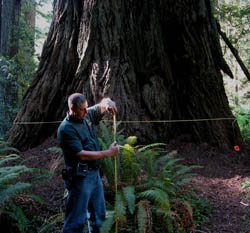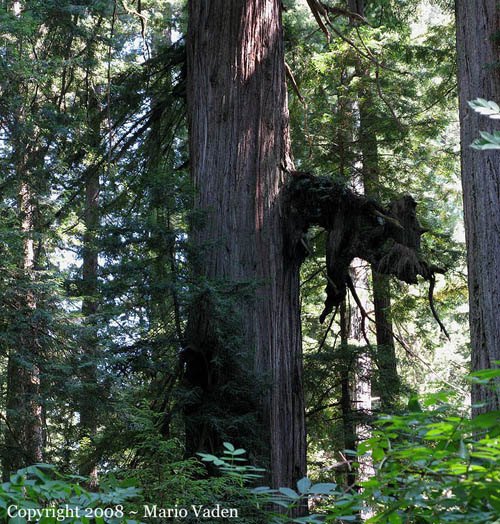
Atlas coast redwood & grove .. #19
Copyright 2009 - 2015 by Mario Vaden

Atlas redwood is a coast redwood within Atlas Grove of Prairie Creek Redwoods State Park. Public awareness of this grove multiplied after author Richard Preston described it in his redwood adventure book of 2006.
The large redwood even provides lodging to small critters. One researcher, Dr. Sillett, found a mumified Wandering Salamader inside a knothole 289 ft. above the ground. That led to to Jim Spickler finding and keeping track of other salamanders, among the redwoods of Atlas Grove. He found some of the same ones several years in a row, and determined that they are territorial. The salamanders basically breathe through their skin and need moisture. This means that various redwoods in Atlas Grove never dry out completely in the upper canopy. There must be some moisture or water stored somewhere throughout the year.
Over the past century, a trickle of people exploring the north redwoods have entered portions of Atlas Grove, the majority passing by, likely not recognizing unusual characteristics or dimensions. Just a handful of people besides botanists or researchers knew both the significance of this grove and it's exact location.
The discovery of this redwood grove by Michael Taylor, meant being first to document it, because others may have appreciated the grove during casual wanderings over past decades. Atlas redwood grove preserves some various historical markings which must date from near World War II. The redwoods of Atlas Grove caught the attention of Michael Taylor in a different way than folks preceding him, because he was on a quest to discover, measure and record redwoods. The documentation was done by Prof. Steve Sillett and his climbing team, requiring months of careful measuring and research.

advertisement
Eventually, names were given like Atlas, Zeus, Iluvatar, Pleiades, Bell, Rhea, Kronos, Broken Top, Buena Vista, Promethius and Ballantine. The Four Horsemen redwoods include one called Poseidon with a huge canopy fern garden (fern mat) called the Heart of Poseidon. I noticed a photo of the Heart of Poseidon stapled to the trail sign near the visitor center at Prairie Creek, showing Dr. Steve Sillett suspended by the enormous mat of leather-leaf ferns. Maybe you've seen the photo too.
Atlas redwood in the midst of what was a study plot called Atlas Project: 1 hectare. The entire Atlas Grove is much larger. Other tree species include Douglas fir, western hemlock, California bay, Cascara, and bigleaf maple. The understory is dominated by western sword fern, California huckleberry, red huckleberry, redwood sorrel and a bit of salmonberry. The main trunk was previously broken between 55 and 60 m giving growth to five large reiterations plus 20 minor reiterations. Atlas redwood held 65 epiphyte mats with approximately 677 kg dry mass of leather-leaf fern. Other epiphytes present within the crown include California huckleberry, cascara, trailing black currant, lady fern and an assortment of lichens.
Epiphyte mats in Atlas redwood appeared to exert a large effect on air temperatures in their immediate vicinity. Compared to the top, air temperatures around the mats were cooler, exhibited less variability, and had higher minimum and lower maximum temps. Relative humidity around soil mats was higher and less variable than the treetop. The size and position of mats within the crown affected humidity patterns. Those which were larger and deep in the crown had higher average and more stable humidity.
Remnants of a broken limb or reiteration on the lower trunk is shown in the photo. It reminds me of a wooden triceratops . Dr. Robert Van Pelt once made a black and white drawing of this redwood. On his drawing that growth shows a small trunk or stem rising upward. It has since broken off.
For reference, 2009 and previous data for Atlas redwood is 288' or 87.8 m high, 20,0' diameter, and 26,938 cubic feet wood volume. The trunk is 9.8 feet diameter at 180 feet high. There were 21 reiterated trunks and fire scars up to 229 feet. 85.1% of the wood volume is in the main trunk. It was the 19th largest known coast redwood.
Even though this redwood is undisclosed, many others in the park are equally impressive for viewing. This park is north of Eureka, and south of Crecent City, California.
